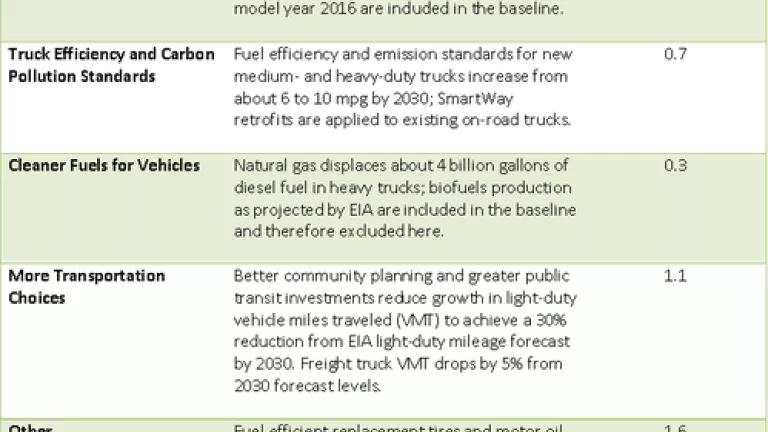
While we face the daily challenge of volatile and currently high gasoline prices, we can be thankful that U.S. consumption of gasoline and oil more generally is flattening. Now we have an opportunity to make our oil demand drop dramatically and help release our household budgets and national economy from the tyranny of oil prices.
We can move farther away from oil with clean energy solutions that increase consumer choices of more efficient cars and trucks, clean non-petroleum fuels and alternatives to driving. Over the next two decades, we can cut demand oil by 5.7 million barrels per day or roughly 30 percent from projected levels.
The demand reductions included in the table above are in addition to recently enacted policies to improve new automobile fleet average fuel efficiency up to the equivalent of 35.5 mpg over model years 2012 to 2016.
The Obama administration’s recent proposal to ramp up automobile standards to the equivalent of 54.5 mpg by 2025 takes another huge step away from oil dependence and will save 1.7 million barrels of oil per day by 2030. When the 2025 standards are combined with a transition to greater electrification of cars (15 percent of new sales in 2030) and on-going modest improvements to conventional vehicles we can cut oil consumption by 2 million barrels per day.
The first-ever fuel efficiency and pollution standards for medium and heavy-duty trucks, enacted in August 2011 for model years 2014 to 2018, are a start to needed on-going improvements with known, cost-effective technologies. We can make major strides to lower the cost of moving freight on highways with better trucks.
The next biggest single opportunity for oil savings is through policies that result in more transportation alternatives to driving alone in a car. Through better public transit and community planning we can make daily commutes and errands without a car. Investing wisely in our communities and transportation infrastructure is a critical task for Congress as it considers reauthorization of the Transportation Bill.
Finally, there are a collection of cost-effective technologies across the transportation, industrial and residential and commercial buildings sectors that can squeeze more work out of each gallon of oil. The on-road stock of automobiles can travel farther on a gallon by using energy-saving motor oil and fuel-efficient tires. Non-road equipment for farms and construction sites can adopt many of the technologies that improve efficiency and cut emissions in freight trucks. Aircraft, marine and rail engines are ripe for improvements. We can also drive down oil use by shifting to the most efficient modes for transporting goods.
We should look outside the transportation sector as well. Improving the efficiency of industrial processes that rely on oil by just 10 percent can cut consumption by hundreds of thousands of barrels per day. Tightening up oil-heated buildings and shifting to more efficient boilers—enabled in some cases by a shift to lower sulfur heating oil—can also take a significant bite out of oil demand.
Until we cut our demand, we will be hostage to the volatility of the world oil market. We can look to our neighbor to the north to see that Canada can produce more oil than it needs but is still subject to the global market prices. Upward pressure on prices will continue as demand for oil increases in the growing economies of China, India and elsewhere. We can, however, control our own destiny by aggressively deploying cost-effective and known technologies and strategies that cut U.S. oil demand. We hold the keys and we just need to stay focused on a clean energy road ahead.

